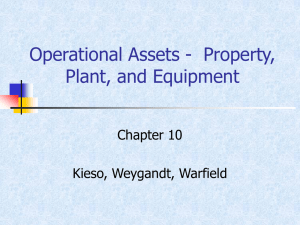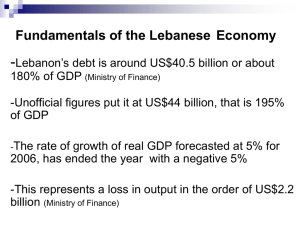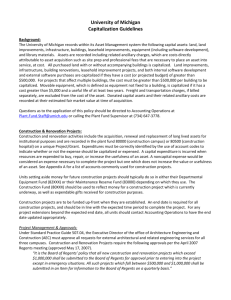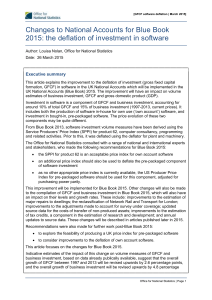questionnaire on base-year current price estimates for
advertisement
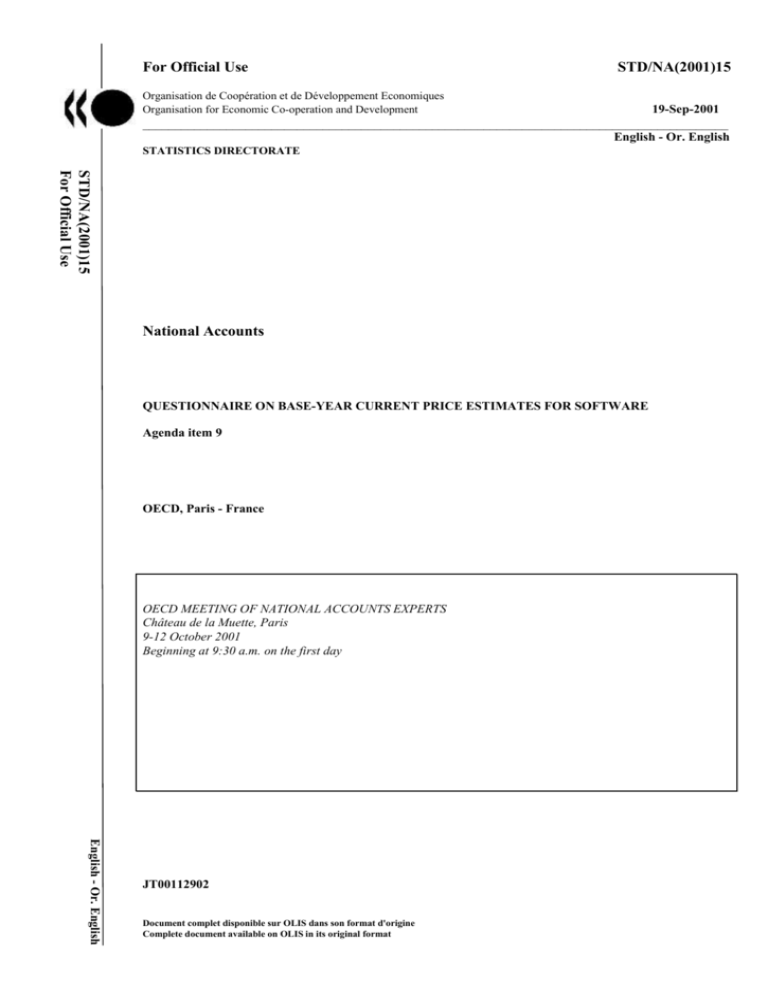
For Official Use STD/NA(2001)15 Organisation de Coopération et de Développement Economiques Organisation for Economic Co-operation and Development 19-Sep-2001 ___________________________________________________________________________________________ English - Or. English _____________ STATISTICS DIRECTORATE STD/NA(2001)15 For Official Use National Accounts QUESTIONNAIRE ON BASE-YEAR CURRENT PRICE ESTIMATES FOR SOFTWARE Agenda item 9 OECD, Paris - France OECD MEETING OF NATIONAL ACCOUNTS EXPERTS Château de la Muette, Paris 9-12 October 2001 Beginning at 9:30 a.m. on the first day English - Or. English JT00112902 Document complet disponible sur OLIS dans son format d'origine Complete document available on OLIS in its original format STD/NA(2001)15 QUESTIONNAIRE ON BASE-YEAR CURRENT PRICE ESTIMATES FOR SOFTWARE The objective of the questionnaire is to obtain two sets of estimates for a sample of countries, one using the “supply” method, and one the “demand” method (in practice many countries would only have to report one method, supposing they already used the alternative one). Countries would indicate the main difficulties encountered. The task force would then conclude which of these methods (or a mix) are the most suitable, both from a national and an international (comparability) point of view. The questionnaire would have five parts. Part 1: actual official data, and impact of that data on GDP Report the most detailed official current price data on software (on a commodity-flow/use and resources basis) for a recent year, preferably between 1995 and 1998. Use the most detailed classification used in the accounts, if possible distinguishing prepackaged, custom and own account software. Table 1 Actual Official Commodity flow Data for Software Year:……. Current prices, Unit:…….. (millions of ????) Total software PreCustom(*) packaged(*) national accounts classification code Domestic production Imports Margins and taxes Total supply Intermediate consumtion Household expenditure GFCF Exports Other (*) use your own detailed classification, if not relevant 2 Own account(*) STD/NA(2001)15 By comparing to GDP, give an estimate of the change introduced in the level of GDP (this includes impacts of changes to other parts of the accounts if relevant, for example, in Canada, deduction of capitalized software included in hardware). A possible calculation is given in the table below but other methods can be used. Table 2 Estimation of impact of change to GDP Market producers Amount of purchased software previously assigned to intermediate consumption and now assigned to GFCF (+) Amount of own account production of software Non market producers (+) Amount of consumption of fixed capital related to software (+ or -) Other impacts on GDP Total impact GDP Part II: “Supply” method: estimate of domestic supply of purchased software Compile, for the same year, an estimate of domestic sales of software from the point of view of software producers, using for example business turnover statistics originating from computer services producers. Precise if the available data are on a product or an industry basis. Start from all industries related to computer services and select the amount of sales/receipts/production deemed to represent “production of software that can be purchased as investment, exported or purchased by household”. Exclude if possible sales between units classified themselves as software producers. Use the most detailed classification available. International comparison will heavily depend on the detailed activities of the units involved, which can, even if they are classified as “software producers”, conduct other computer related activities, such as “hardware sales”, “consultancy”, “repair and maintenance of computers”, “training”, “data processing”, etc. For example, in Denmark, only 28% of the turnover of enterprises classified as “software suppliers” were in fact linked to software supply, while 43% of the turnover was in “consultancy” and 15% in “hardware sales”. Conversely, 26% of the turnover of units engaged in “data processing” were linked to software sales. Table 3 “Supply” method: estimate of domestic supply Classification code …… …… Industries related to computer services Title …………………….. …………………….. Estimate of total sales/production/sh ipment, in current prices ………….. ………….. Explain briefly the process of selection: 3 Select amount to be classified as software that can be purchased as investment, exports, final consumption (in particular exclude sales between units classified as software producers) ……………….. ……………….. STD/NA(2001)15 Estimate adjustments to be conducted on the total value of domestic sales/production/shipments software that can be purchased as investment, exports or household consumption to derive the value retained for GFCF in software. Table 4 Adjustments to supply of domestic software Total value of domestics sales/production/shipments of software purchased as investment, exports or household consumption (-) Exclusion of software embedded in other equipment (intermediate consumption) (-) If relevant, deduction of capitalized software reported by enterprises under hardware or other headings (+ or -) Other adjustments (-) Estimate of exports (-) Estimate of household consumption (=) GFCF in software, “supply” method Because purchasers of software record a substantial part of purchases as current expenditure, estimate, if relevant the adjustment made (or that would have to be made) on the value of corporate profits obtained through business statistics in the income approach to GDP: Table 5 Income approach: adjustment to corporate profit National accounts estimate of GFCF in software for the business sector Business estimate of GFCF in software Adjustment to be made to corporate profits in the income approach to GDP Part III: “Demand” method: estimation of capitalized software, using reports from enterprises and other organizations, including government Use business survey data or administrative data, if possible covering the same year, to derive an estimation of software capitalized by the corporate and government sectors. In principle this estimate should include capitalized own-account software. If possible, separate the latter. Table 6 Demand method: capitalized software Business sector Reported capitalized software Of which, own account software Government Reported capitalized software Of which, own account software 4 STD/NA(2001)15 Part IV: estimate of expenditures in software as reported by enterprises and other organizations, including government Use business survey data, if possible covering the same year, to derive an estimate of expenditures in software as reported by the corporate sector and government. Precise if this estimate includes own account software. If possible, estimate it. Table 7 “Demand” method: purchased software Business sector Reported expenditures in software Of which, “expenditures” in own account software Government Reported expenditures in software Of which, “expenditures” in own account software Part V: macro-estimate of own account software Evaluate the value of own account software on the basis of costs, estimated at a macro level. The recommended method: number of person engaged in software production time average compensation, plus estimate of intermediate consumption and consumption of fixed capital, plus adjustments. Table 8 Macro estimate of own account software Number of person engaged in software production * Average compensation = Compensation cost of producers of own account software (+) Over-costs (intermediate consumption, consumption of fixed capital) (-) Adjustment 1 : exclude cost of production linked to purchased software (-) Adjustment 2 : exclude costs linked to other activities (repair, management, other…) than software production (+ or -) Other adjustments Macro estimate of own-account software 5

